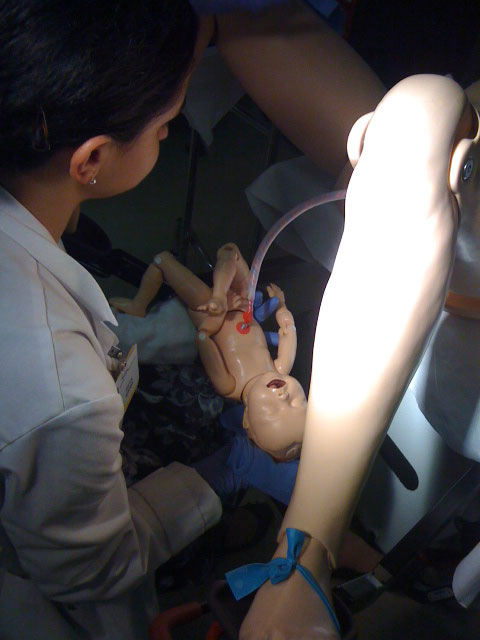Med student exam scores improve with simulation training in obstetric clerkship, USF study finds
Medical students who practiced on a patient simulator before assisting in real-life vaginal deliveries scored significantly higher on their final examinations than did students receiving a lecture only at the start of an obstetric clerkship.
Results of the University of South Florida randomized, controlled trial appear in the September 2011 issue of the high-impact journal Obstetrics & Gynecology.

From left, fourth-year medical students Krystle Hunt, Nathaniel Walsh, and Anna Wouters, and Dr. Shelley Holmstrom.
The USF researchers also found that students receiving simulation training were initially more confident of their ability to perform a vaginal delivery, although these differences narrowed over time as all the students participated in actual deliveries.
“The simulation training engaged the students early on,” said lead author Dr. Shelly Holmstrom, assistant professor of obstetrics and gynecology at USF Health. “As a result, they may have been more invested in the clerkship and absorbed the information more effectively and comprehensively. That may explain why these students scored higher on their oral and written examinations.”
Previous smaller studies have looked at the effects of obstetric simulation training on student confidence, comprehension, satisfaction, and comfort in performing common obstetric procedures, including vaginal delivery maneuvers such as controlling the head, delivering shoulders and examining placenta. The USF study, which enrolled most students rotating through the medical school’s maternal newborn clerkship last year, is one of the first, however, to evaluate simulation’s effect on students’ final examination and evaluation scores.

Fourth-year medical student Divya Arora helps deliver a simulation baby during clerkship.
The study followed 113 out of 119 third-year medical students rotating through USF’s four-week maternal newborn clerkship from February 2010 through January 2011. At the start of the clerkship, students were randomly assigned to either a traditional lecture on performing a vaginal delivery or a lecture followed by a hands-on vaginal delivery simulation. The instructor demonstrated a vaginal delivery using a NOELLE® birthing simulator, computerized life-size maternal and neonatal mannequins, and then let each student practice at least one simulated delivery.
Participants completed confidence assessment surveys before their assignment and four weeks after training. End-of-rotation examination scores were compared for the simulation and non-simulation groups.
Immediately after the simulation training, more than 52 percent of the students reported they felt confident enough to perform vaginal delivery maneuvers with minimal supervision or independently with assistance from an attending physician. Only 16 percent of students in the lecture-only group were confident they could do the same. By the time the students completed their first three actual deliveries, there was no difference in self-assessed confidence levels between the simulation and non-simulation trained groups.
Simulator-trained students scored significantly higher on their oral and written examinations, even though the number of vaginal deliveries in which both groups participated did not differ.
A growing body of evidence indicates that simulation shortens the learning curve for mastering technical skills and is valuable in measuring how well medical/surgical teams solve problems when confronted with complications.
Simulation can be used to teach medical students and physicians in a safe environment without risk to an actual patient, Dr. Holmstrom said. The ability to realistically recreate high-risk, as well as routine, clinical scenarios through simulation is critical in obstetrics training, because a seemingly normal delivery may rapidly turn complicated, even potentially life threatening.
While high-risk complications like breech delivery, postpartum hemorrhage and shoulder dystocia (baby’s shoulder stuck in the birth canal) are relatively uncommon, Dr. Holmstrom said, “when they do happen, you need to know exactly what to do and react very quickly.”
Dr. Holmstrom initiated the study while participating in the Association of Professors of Gynecology and Obstetrics (APGO) Academic Scholars & Leaders Program. She presented the findings at the joint annual meeting of APGO and the Council on Resident Education in Obstetrics and Gynecology this spring in San Antonio, TX.
The study’s co-authors are Katheryne Downes and Dr. James Mayer, both of USF Health, and Dr. Lee Learman of Indiana University. The obstetric clerkship simulation training was conducted at the USF Department of Pediatrics TEAM Education and Multidisciplinary Simulation (TEAMS) Center.
Story by Anne DeLotto Baier, USF Health Office of Communications.

